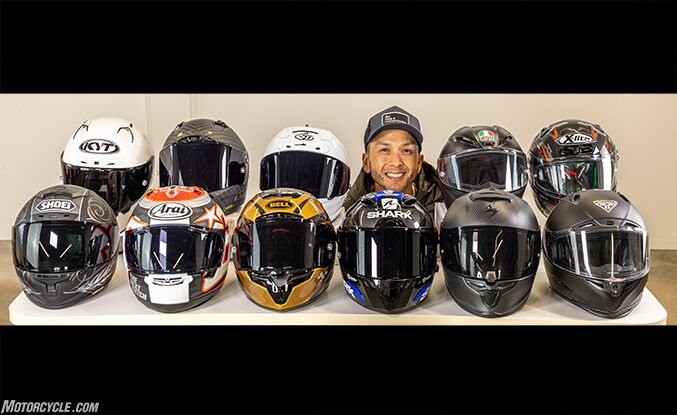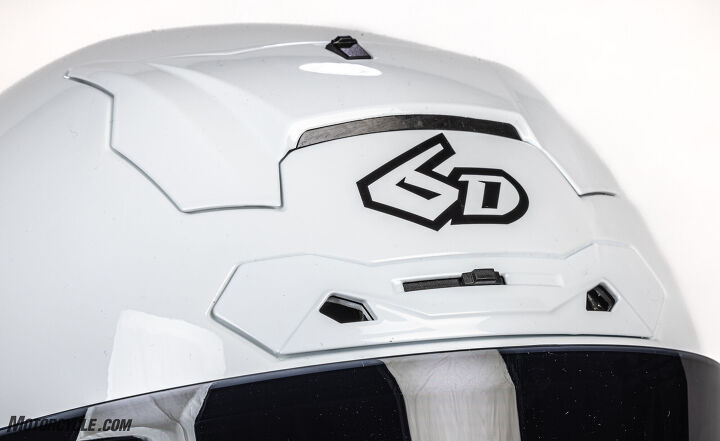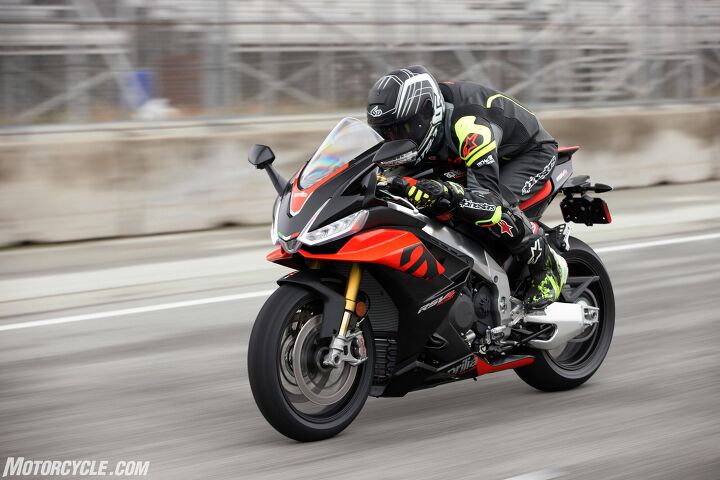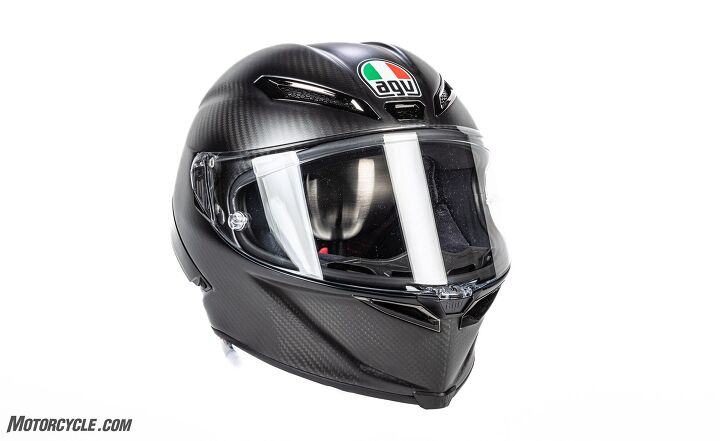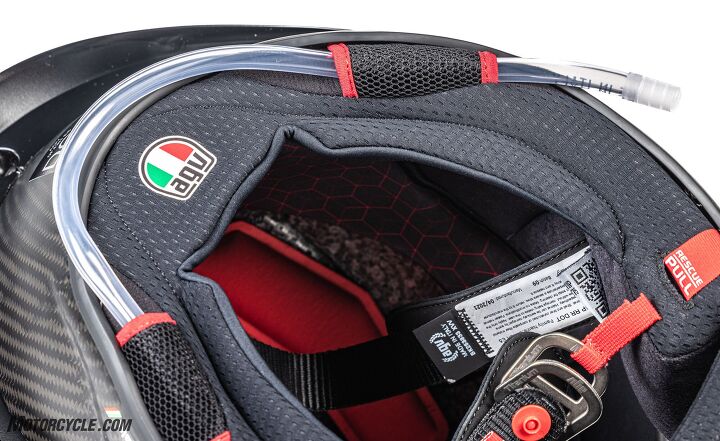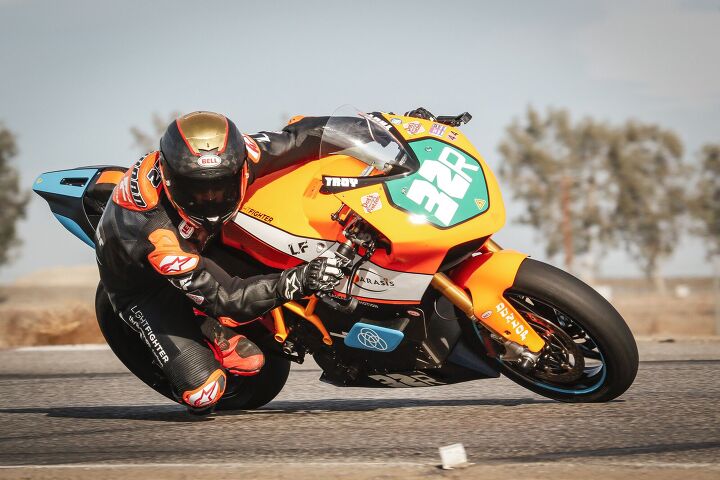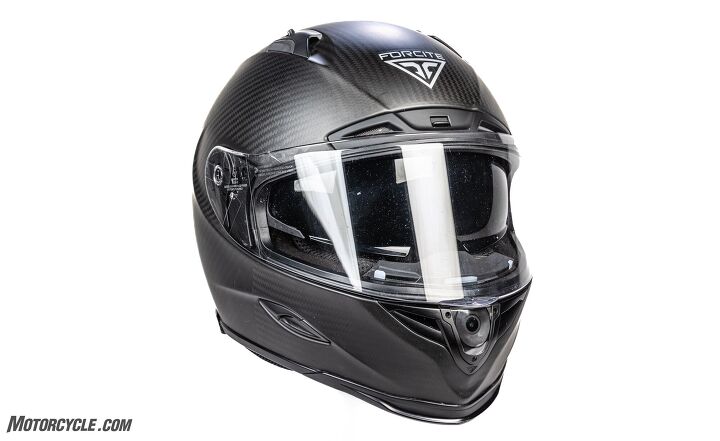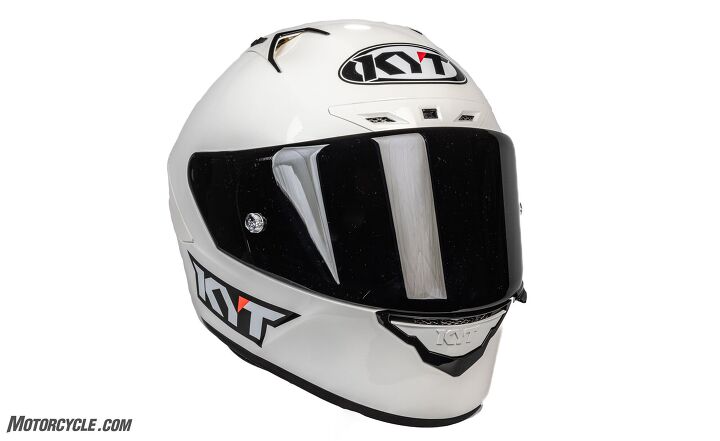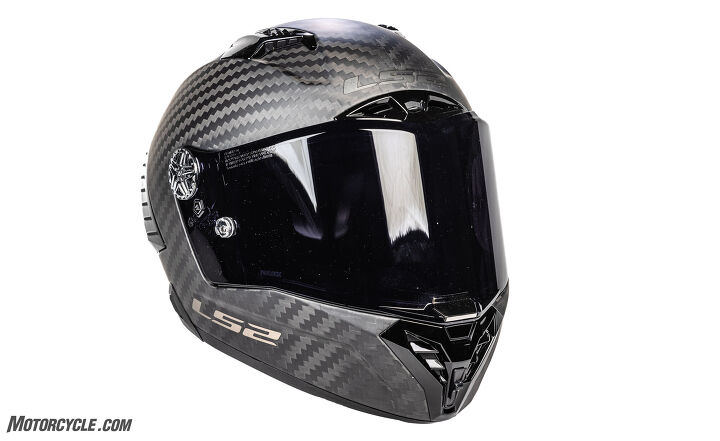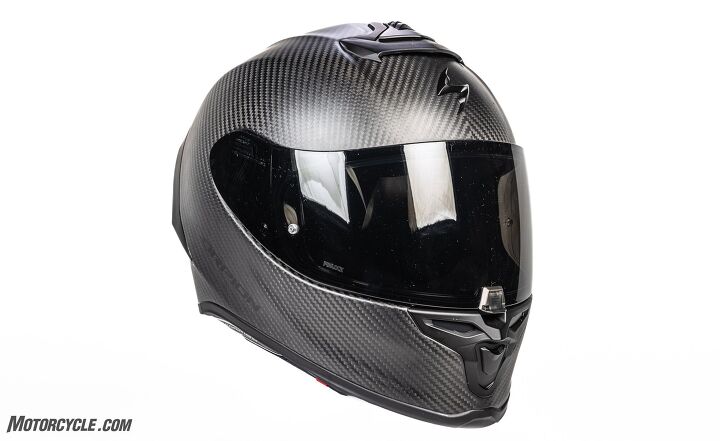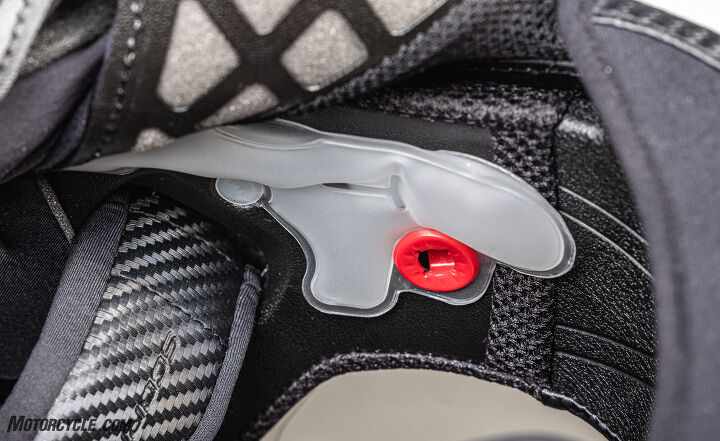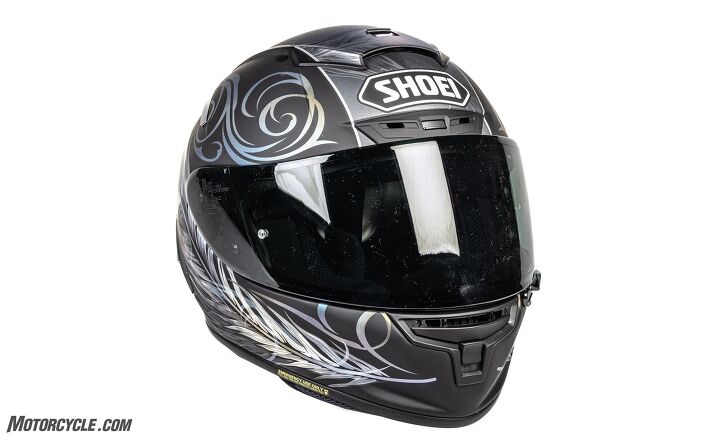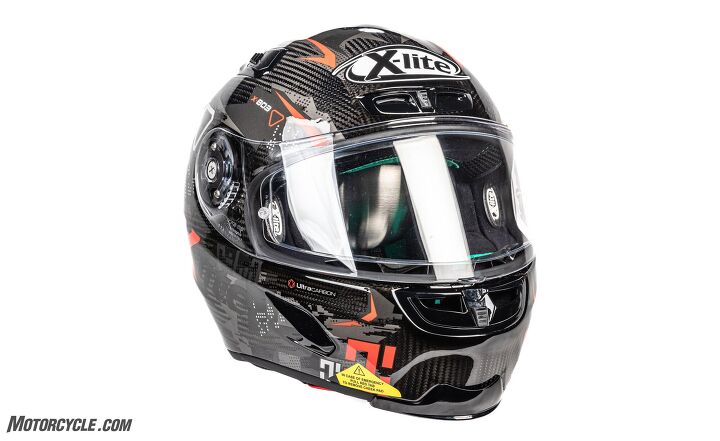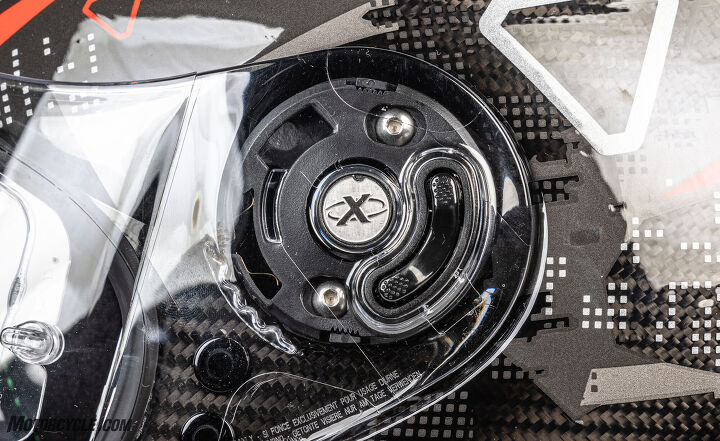Motorsports Racing News & Blog Articles
2021 Motorcycle.com Mega Helmet Shootout
If you’re a regular reader of Motorcycle.com, then you’ve probably noticed we’ve done a lot of shootouts this year. First, we put together a few middleweight Twins, then some extra-middleweight Twins, followed by a gang of lightweight twiddlers, then ending at the other end of the spectrum with the gnarly crew of heavyweight nakeds on the street and the track. It’s been quite the year with a lot of riding and testing involved. And just when you thought our shootouts were over…
Bam! We’re hitting you with another one. This time we’re leaving the bikes alone (haven’t we tested them all already?) and putting together a collection of premium helmets to wear side-by-side. Because if there’s one question we get time after time (after which motorcycle is the best?), we’re also constantly asked which helmet is better than another.
Here we present to you Motorcycle.com’s first helmet shootout, featuring 11 flagship racing helmets from nearly every helmet company selling products in the United States. And they are:
| 6D ATS-1R | AGV Pista GP RR | Arai Corsair-X | Bell Race Star Flex |
| Forcite MK1 | KYT NZ-Race | LS2 Thunder Carbon | Scorpion EXO R1 Air |
| Shark Race R Pro GP | Shoei X-Fourteen | X-Lite X-803 |
You might have noticed these are all top-of-the-line racing helmets. This wasn’t a coincidence. Even if you don’t race and have no intentions of wearing a race helmet, like all tech in the powersports industry, the innovations first developed in racing eventually find a way to trickle down to the rest of the products in the family. Unless we’re talking about half helmets. They don’t call them brain buckets for nothing…
But I digress. Hawkeyes might also notice a couple of companies missing from this lineup: HJC and Suomy. We reached out to both companies, and HJC is in the process of transitioning to a new premium helmet – the RPHA 1 – and didn’t have any to provide in time for this shootout. Suomy never returned any of our request inquiries and were subsequently left out.
The Game Plan
Here’s how this is going to work. I wore all the helmets, primarily during the track portion of our Heavyweight Naked Bike Shootout. In between jotting down notes of each bike, I also scribbled some thoughts about each helmet. Every time I hopped on a different bike, I plopped on a different helmet. Below are my thoughts on each. Before riding with the helmets I also measured each one on my kitchen scale, exactly as tested.
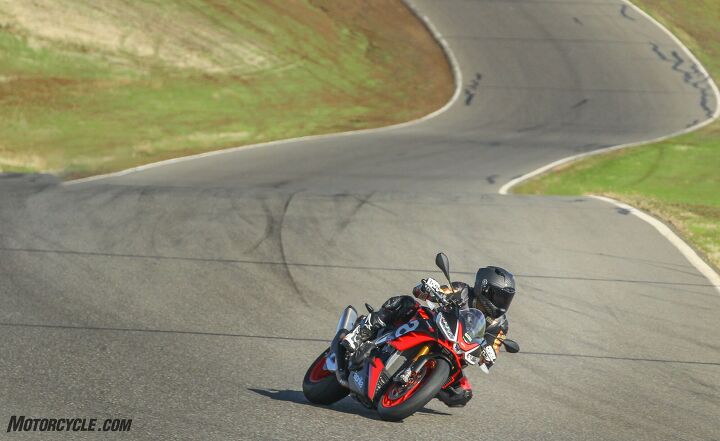
It was hectic enough evaluating seven motorcycles, but we decided to throw in a bunch of helmets to test, too.
For reference, I have an intermediate-oval head measuring 57cm around. I typically prefer my track helmets to fit pretty tight around the cheeks and to be snug around my forehead. As such, I typically wear a Small or Medium helmet, depending on the brand, and occasionally need to switch cheek pads to accommodate. When such an occurrence happens, I’ll note it for that particular helmet.
Note that you can switch pads, too, with a call to your retailer. Also, keep in mind if your head shape is vastly different from mine (say if you’re a long-oval or round head), the impressions on fit probably won’t apply to you. This is why it’s important to physically try on helmets to determine the best size for you. Because a helmet with all the features in the world is worthless if it’s sitting on your shelf because it doesn’t fit.
Unlike a typical motorcycle shootout test, this one isn’t going to have any winners or losers. There are too many variables to honestly give a helmet a top rating over another. In this case, size and shape are big factors, but DOT, SNELL, ECE, or even FIM homologation will also be listed. Speaking of which, this test is not going to delve into the details of each safety rating other than to point out which standard(s) each helmet conforms to. You can decide for yourself which rating to subscribe to.
With that, here are my thoughts on each helmet, in alphabetical order.
6D ATS-1R
Price: $695 Tested size: S Weight: 3 lbs., 8.7 oz. (1607.4g) Safety Rating: DOT, ECE 22.05, ACUWe start this shootout with a helmet, and a company, looking to change the game when it comes to helmet technology. 6D takes a different approach to mitigating impact energy to your head in the form of its ODS, or Omni Directional Suspension technology. Basically, 6D helmets employ several hourglass-shaped isolation dampers sandwiched between the inner and outer multi-density EPS layers. The EPS layers combined with the hourglass dampers “provide a progressive spring rate that manages low and mid-threshold accelerations, while simultaneously allowing the inner EPS liner to displace and shear in 3-dimensional space within itself. This omni-directional suspension capability provides ‘six degrees of freedom’, which became the inspiration for our company name; ‘6D Helmets.’”
Instead of trying to explain ODS, you can see how it works directly from 6D:
In short, 6D helmets reduce energy transfer to the brain over low-, mid-, and high-speed impacts, from all angles, by essentially suspending the head for a fraction of time within the helmet as the dampers and EPS layers absorb and disperse impact energy. At the same time, the inner EPS layer (the one closest to your skull) is isolated from the outer layer (and thus free to move independently) via the dampers. This momentary gap in time between the outer EPS layer initiating impact and the inner EPS layer finally crushing the dampers to the point that it absorbs impact energy, greatly reduces the amount of energy transferred to your brain.
We could do an entire separate story on 6D helmets, but that’s the gist of 6D’s approach. For those who want more literature backed by independent lab results on the ODS technology, the 6D website is full of more resources to read.
The rest of the ATS-1R is fairly standard fare. You have a carbon fiber shell, an anti-scratch shield with a locking tab that can be replaced without tools. A clear Pinlock insert is included in each purchase to keep foggy visors at bay. Four adjustable air intakes funnel in air that then gets distributed to 15 different channels inside the helmet to help keep your head cool before exiting out the five exhaust vents. The rear spoiler was designed in CAD to limit drag, buffeting, and lift at higher speeds.
Despite my head measuring 57cm, which 6D’s size chart says would put me in a medium, I’ve found the size small to give me the snug fit I like in a race helmet (though I’d probably opt for the medium if this were my street helmet for long-distance comfort). For me and my head shape, this gives me the tight fit around the cheeks and snug fit around the crown that I like. Obviously, your tastes may vary.
Clearly, 6D has gone in a different direction when designing the bits to potentially save your life, but when it comes to the touchpoints of the ATS-1R, it simply feels like a helmet. This is a good thing. Changing the status quo is all well and good, but when there are aspects of the old regime that still work, like interior fit, materials, and comfort, as the saying goes, “If it ain’t broke, don’t fix it.” If you’re thinking it would be bulkier, think again. When it’s on your head you don’t notice anything different than before. It’s just a helmet.
The view out the eye port is great, even in a tuck. I had clear vision even in my periphery. The shield itself is dark, which I like, easy to change, and has a 10-step range with detents you can feel with each click up or down. Once the shield is finally closed, a nice thud tells you it’s all the way down and secure, and I didn’t experience any air coming through the shield. In fact, the ATS-1R is a fairly quiet helmet, even at 160 mph or so, down the front straight at the Bahrain International Circuit.
Aero-wise, the fact I don’t have many impressions about the ATS-1R tells me it slices through the air with minimal buffeting, with everything working in the background.
In case you didn’t notice, I’m a fan of the 6D ATS-1R. Not only does its technology fascinate me, but its overall fit and performance are top-notch.
AGV Pista GP RR
Price: $1399 – $1750 Tested size: MS Weight: 3 lbs, 7.2 oz. (1564.9 g) Safety Rating: DOT, ECE 22.05, FIM homologatedThe most expensive helmet in this shootout, the AGV Pista GP RR is the same helmet Valentino Rossi, and any other AGV-sponsored racer, wears. Representing the pinnacle of AGV’s helmet lineup, the Pista GP RR features a 100% carbon fiber shell, metal alloy air vents, and a very simple visor release mechanism with minimal parts and a slim profile.
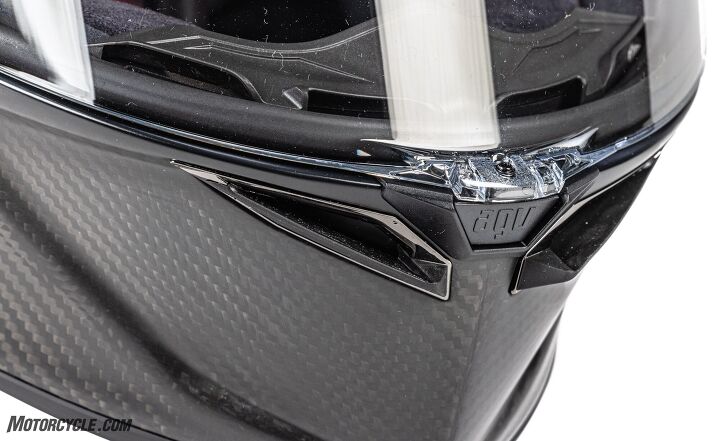
The wedge-shaped chinbar helps split the air at speed. Note the metal scoops protruding from the chin vents.
Speaking of its profile, the shape of the helmet is very much a distinctive AGV trait, with a wedge-shaped chinbar design AGV says helps reduce fatigue on the rider by splitting the air. Metal alloy air vents with scoops protruding from the chin vent help funnel air into the helmet to cool the rider. Similar scoops above the rear exhaust vents help direct the exiting air past the spoiler for a cleaner path down the rider’s hump on their leathers for ultimate aero efficiency. In fact, AGV says at 160 kph (99 mph) – the average speed during a fast lap – the aerodynamics of the Pista GP RR cancels out the dynamic weight of the helmet itself.
Vision is wide and clear. The optical class 1 visor encloses an eye port giving a 190º visual plane in the horizontal direction and 85º in the vertical. A physical latch keeps the visor mechanically closed and secured, which I’m sure is comforting for MotoGP riders going 220-plus mph down the Mugello front straight.
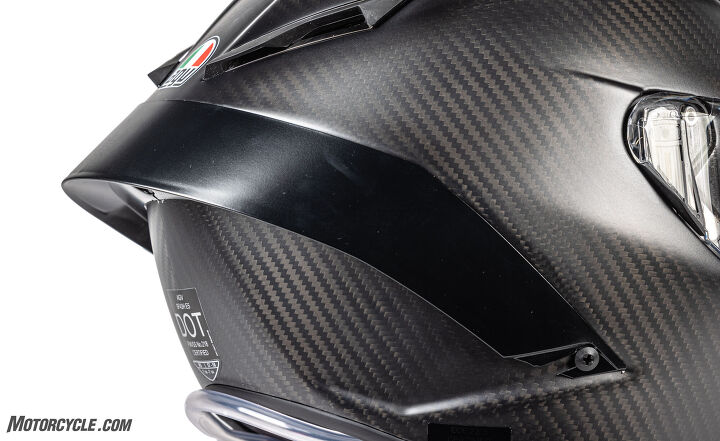
The rear spoiler shape was designed especially for high-speed stability. Like the chin vents, you’ll also see the metal scoops above the exhaust vents.
A helmet that costs this much has to deliver when it comes to the fine details, and not only does AGV offer options like two different ranges of the size medium (medium-small and medium-large) to truly narrow down proper fit, but also its 360º adaptive fit system lets the user fully customize the crown, cheek pads, and neck. Inside the box are 17 different pads of various thicknesses to customize the fit exactly as you want it. Lastly, the Pista GP RR is the only helmet we know of that includes a drink tube, though the hydration bladder it feeds from is separate.
This is the point I have a confession to make; this is the only helmet of the 11 I haven’t worn in a racetrack environment. AGV delivered this helmet past our deadline and it didn’t make the trip to Thunderhill for a proper track evaluation. This is really too bad, as wearing each helmet back-to-back, like I did with the others, highlights sound level differences, among other things.
What I can report back is the 360º adaptive fit feature really is daunting at first. The initial fit of the helmet was a tad loose around my temples, and there are so many different ways to alter the fit of the helmet I didn’t know where to start. Ultimately, I decided to go directly to the temples and adjust one thing at a time, adding padding in certain areas and moving the crown around until I was happy with the fit. At normal street speeds, I’d be lying if I told you I could really feel a difference in the AGV’s aero claims, though the Pista felt light enough and was a non-issue at speed.
I’m a fan of the Pista’s simple yet clever shield change mechanism, and the view out of the eye port leaves nothing to be desired. It’s huge. From here, though, a track evaluation will have to wait.
Shop for the AGV Pista GP RR here
Arai Corsair-X
Price: $850 – $979.95 Tested size: M Weight: 3 lbs., 8.3 oz. (1596.1 g) Safety Rating: DOT, SNELLA helmet needing no introduction, the Arai Corsair-X is well known in motorcycling as Arai’s top racing helmet. Like all Arai helmets, its proprietary fiberglass weave is constructed entirely by hand by skilled technicians who train and study for years before ever putting a helmet together (you can read more about the Arai process and philosophy here).

Each Arai is made by hand. The shell is measured for thickness at two points in the manufacturing process. In fact, no matter which factory in which the shell is created, they are all inspected at the main Ōmiya factory – a step that requires the shells to be shipped between factories. The boxes of shells can be seen in the background.
With the Corsair, Arai’s signature R75 shape is used, and it refers to the round, eggshell shape we’ve come to associate with the brand. The 75 refers to the radius of the shell being a constant 75mm. According to Arai, the R75 shape is the optimum roundness to be able to glance off unmoving obstacles in your path, thereby absorbing far less impact energy in the first place.
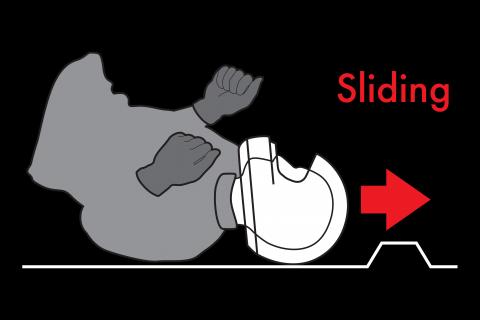
A graphic that Arai uses to support its glancing theory. The round shape will “glance off” the obstacle, while sharp curves other helmets employ could potentially “catch” on the obstacle and cause secondary damage to the wearer.
The Corsair-X features two huge air intakes atop the head, with a center intake allowing more air to come through. Below those, eyebrow vents built into the face shield direct incoming air through ducting inside the helmet. Those five vents at the top of the head can pair with the big chin vent to let in a huge amount of air to help cool you off on warmer rides. The air then escapes through a number of exhaust vents out the back.
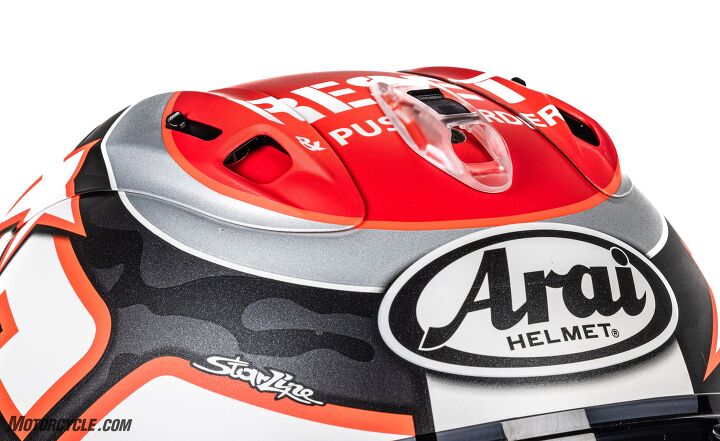
These huge air vents flow a ton of air through the Corsair, but it also contributes to the helmet’s loud interior.
Apart from its shape and vents, Arai is most famous (borderline infamous) for its shield-changing mechanisms. The Corsair-X actually is one of the easier Arai designs I’ve used, as prior iterations basically amounted to the user jamming the end pieces of the new shield into the side pods in hopes they would catch. The new shield change mechanism unhinges the side pods, so you can see the pieces you need to align to take a shield on or off.
Having worn my fair share of Arai helmets during my riding career, I’ve come to know exactly what to expect from them – or so I thought. I know that, out of the box, Arai’s will fit my head perfectly, with every pad contouring to my face nicely. I also know the standard cheek pads will also break-in quickly, and once they do, the fit around my cheeks will start to feel loose. I’ve remedied this by ordering thicker cheek pads (an option anyone can do), so I get chipmunk cheeks at first, but a perfect fit after the pads break-in.
With all the vents open, the Corsair flows in a lot of air. As a byproduct, all that air results in a loud helmet. I’d heard this before but never truly appreciated it until wearing all of these helmets, one after another. The Corsair is loud, even with earplugs. But this is the price you pay for excellent ventilation and airflow.
The Corsair-X features a small, adjustable spoiler between the exit points for the top exhaust ports. Arai will also sell you a more substantial plastic spoiler you fasten with adhesive behind the top air vents. You might have seen MotoGP or World Superbike Arai athletes using these. I’ve worn the helmet with and without this spoiler and I’d be lying if I said I could feel an appreciable difference. Which isn’t to say there isn’t one. But still…
Shop for the Arai Corsair-X here
Bell Race Star DLX Flex
Price: $769.95 – $869.95 Tested size: M (with standard 30mm pads replaced with 45mm pads) Weight: 3lbs 7.0 oz (1559.2 g) with 30mm pads, 3 lbs 7.4 oz (1570.6 g) with 45mm pads Safety Rating: DOT, SNELLOne of the most recognizable names in helmets, Bell’s Race Star DLX Flex is its premier road racing helmet. It’s the same one you’ll see all of Bell’s sponsored racers wear on their head. It’s an impressive helmet, too, with its 3K carbon fiber shell construction. To provide a better fit across the range of sizes, the Race Star DLX comes in five different shell sizes and six impact liner sizes, for an exacting fit. Some other helmet makers will use three shell sizes to span the entire size range, and use a vast array of pad thicknesses to account for different helmet sizes.
Speaking of cheek pads, this Race Star’s cheek pads are secured using magnets as part of Bell’s clever Magnefusion magnet system. This makes it extremely easy to pull pads in and out for cleaning or, heaven forbid, for emergency personnel to remove the helmet from a fallen rider.
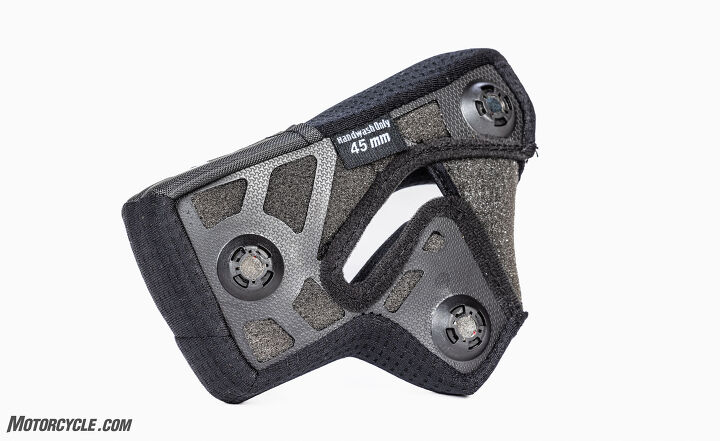
The three magnets securing the cheek pad to the shell are ingenious. The pads are super simple to take in or out and stay solidly in place when riding.
Bell’s other innovation is the Flex Energy Management system. Comprised of a three-layer impact liner of different densities, it’s designed to mitigate impact energy in the event of low-, mid-, and high-speed impacts. What’s more, the low-speed liner – the one closest to your head – resides within a slot between it and the mid-speed liner, creating a slip plane that acts to absorb some rotational energy, similar to the MIPS system.
In the US, this helmet comes with Bell’s Panovision photochromatic shield that changes how dark it gets depending on the ambient light. Interestingly, in the US the Race Star is only certified with the DOT and SNELL M2020 rating. In Europe, a very similar helmet wears an ECE sticker, and certain sizes are even FIM homologated.
Personally, the Bell Race Star DLX Flex is one of my favorite helmets and the one I’ve been wearing the past few seasons whenever I race. After exchanging the standard 30mm cheek pads in my medium helmet for thicker, 45mm pads, I couldn’t ask for a better fit. It’s tight around the cheeks and snug around my crown. No, the ventilation and airflow don’t quite match the Arai, but it flows well enough and is significantly quieter than its Japanese counterpart.
Vision from the eyeport is huge, and the large tab at the front of the visor is practically impossible to miss if you’re trying to get the shield up or down. What’s more, the single-button shield change mechanism is very slick and easy to use. Aero-wise, its shape doesn’t particularly stand out from the crowd, but at the same time, I can’t recall a time I’ve been jostled about at high speeds while wearing it either.
All in all, the Bell Race Star Flex DLX is simply a solid helmet and a smart choice. Assuming it fits your head, of course.
Shop for the Bell Race Star DLX Flex here
Forcite MK1
Price: TBD. US availability pending in 2022 Tested size: M (with optional 30mm cheek pads) Weight: 3lbs 7.6 oz (1576.2 g) Safety Rating: ECEIf you haven’t heard of Forcite helmets before, you’re not alone. This Australian brand is primarily available in its homeland, though further expansion into North America is slated for 2022, pending global pandemic and supply chain issues resolve themselves enough for that to happen.
So, why are we even including a helmet you can’t buy yet? Because it represents something we think is pretty cool in the smart helmet landscape. It features a camera built into the chin bar, speakers integrated into the ear recesses, and a built-in microphone. It’s essentially a motovlogger’s dream! What’s more, you can connect your Forcite helmet to your phone via the Forcite app, allowing you to listen to music, get calls, or even get directions (also from the Forcite app). More than just a conduit to getting GPS directions, the Forcite app can also communicate with you via small colored LED lights on the bottom edge of your field of view to warn you of police, road closures, accidents, or other imminent hazards (you can also opt to turn all these alerts off).

This is the big talking point with the Forcite MK1: the built-in HD camera. Accompanying earbuds and microphones are also embedded within the helmet. Check out the video at the top of this story for some riding footage from the camera.
But what about the helmet itself, you ask? Well, it has a carbon fiber shell and meets full ECE 22.05 certifications. In fact, the camera and its associated electronics are mounted on a dedicated plate within the chin bar to not only keep the equipment in place but to also flex upon impact to help absorb and dampen the shock.
Weighing in at 1576 grams, the Forcite is far from the heaviest helmet in this bunch. Though it’s worth noting that the weight distribution is significantly placed towards the front, which really isn’t surprising. Eight ventilation channels flow air through the helmet, while a flip-down sun visor helps keep harsh sunlight at bay.
Sticking to a size medium, I had to replace the standard pads with thicker ones to fit my face better, but after I did that I was pleasantly surprised with how comfortable the Forcite MK1 was. With the helmet on and strapped, it feels like any other helmet.
My Forcite MK1 was made in Taiwan, assembled in Australia, and is basically an early production model. This is evident in the sun visor getting stuck when pushing the lever down and some panel gaps between the shell and liner. We’ve been promised the MK2 addresses both issues by getting rid of the flip-down visor and paying closer attention to quality control as the helmet leaves the shop. Further software updates are also part of the MK2 upgrade.
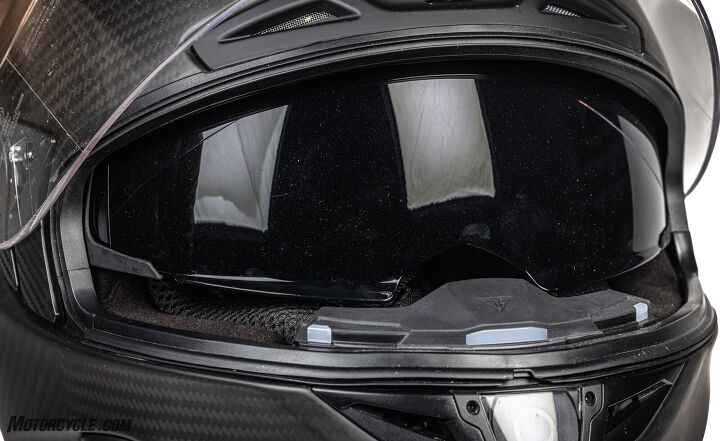
A flip down visor is a nice feature when conditions start to vary, but the unit on the Forcite is clumsy and often gets stuck within its railing. We’re told it’s disappearing with MK2. Note the three lights at either side and the middle of the breath guard. They light up in different colors when the helmet is paired to the Forcite app on your phone.
As for the primary selling point, the camera, I’m impressed with the results. No, the video quality won’t be giving GoPro any scares at the moment, but it’s still high definition and infinitely easier to capture footage (and commentate) compared to the GoPro. The GPS functionality was pretty nifty, but because the app isn’t completely ironed out for US roads, the alerts system wasn’t entirely accurate.
Overall, as someone who rides motorcycles and talks about them on video, having something like the Forcite MK1 is nice. Yes, it shows some teething issues that are to be expected with startup companies, but if version 2 addresses and improves upon, then Forcite could have a winner on its hands.
KYT NZ Race
Price: $449 – $499 Tested size: S (with thicker pads from a medium) Weight: 3lbs 1.1 oz (1392.0 g) Safety Rating: ECE, FIMHere’s another helmet you may not have heard about before. KYT is headquartered in Indonesia and has a large following in the Asian market and even Europe. Several riders in MotoGP and the supporting classes wear the NZ Race on their heads, including Aleix Espargaro. Breaking into the American market is no easy task, but the company is slowly finding its feet in the US, and it’s starting with its flagship helmet.
The details surrounding the NZ Race aren’t too dissimilar from other helmets. Its tri-composite shell (carbon, fiberglass, and Kevlar) is produced in two sizes, Medium and Large. Having only two shell sizes means the internal EPS liner is available in three sizes: Small, Medium, and Large, meaning the actual sizes you order are variations of different pad and liner thicknesses.
Nonetheless, the NZ Race still meets both ECE and FIM homologation standards and is the lightest helmet in this test. Three front air intakes (two on top, one on the chin) funnel air through the internal channels, where it then exits the rear of the helmet. The eye port is nice and big, and the variable thickness visor is anti-scratch and comes with a clear Pinlock insert. Better still, the shield can be changed without any tools.
Being that KYT is based in my ancestral home, I really wanted to like it. And in fact, there is one major thing I like: its weight. While none of the helmets felt particularly heavy on my head, the KYT feels especially light even sitting still. Then when I’m riding it feels like it has practically disappeared.

It might have given me a hot spot on my forehead, but the lightness of the NZ Race was appreciated. Photo: Dito Milan/Gotbluemilk.com
However, the NZ Race reveals one of the flaws of having such a limited shell size range – proper fitment. The Small I was sent also had various cheek pads and liners, and while I got the pads to squeeze my cheeks the way I like, the crown of the helmet gave me a severe hot spot in the middle of my forehead, making it uncomfortable to wear after a 20-minute session on track. Adding to the complaints list is just how loud the helmet is, even with earplugs. I assume this means air was flowing through the vents, though I was hard-pressed to actually notice it. It didn’t seem like it was coming from under the neck roll or chin, which is a good thing.
Without a larger shell to compare it to, my jury is still out on the NZ Race. If a larger crown comfortably fits on my head, the lightness of it is intriguing (yes, I know a larger size will be heavier), the view port is nice and big, and the dark shield is truly dark – just how I like it. If a size up fits, the wind noise wasn’t enough to be a deal-breaker.
LS2 Thunder Carbon
Price: $699.98 Tested size: M Weight: 3lbs 4.2 oz (1479.9 g) Safety Rating: DOT, ECE, FIMIf a helmet can be intimidating, a name like Thunder Carbon would be fitting for it. In fact, LS2’s premier helmet isn’t intimidating at all. Impressive would be the better word. Designed with help from engineers and racers that compete in several top-tier categories including MotoGP and World Superbike, the LS2 Thunder Carbon is relatively light at 1480 grams, largely due to, you guessed it, the carbon fiber construction (with Kevlar reinforcement). We were also sent a size small and it weighed in at 1454.4 grams. Not only is the carbon construction a big reason for the weight, but judging its aesthetics for a moment, the carbon weave is so intricately woven it creates its own eye-pleasing design.
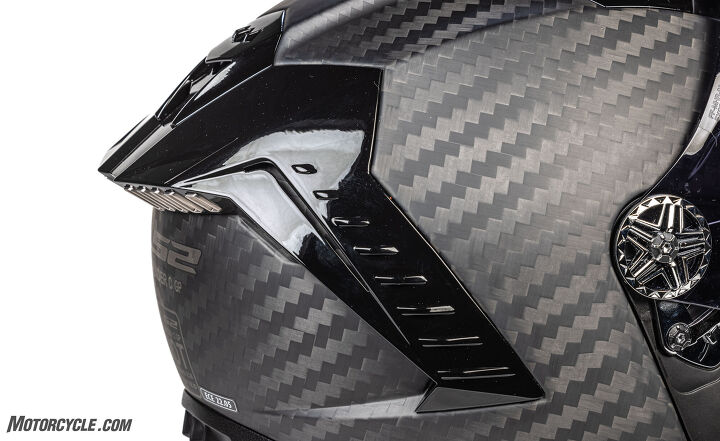
Up close, you can see how aesthetically pleasing the carbon weave is to the eye. Also, the black finish disguises how extensive the spoiler is.
But back to the nuts and bolts of the Thunder Carbon. The blacked-out theme extends to the intake vents and trim pieces, but also to the rear spoiler. I think the black actually disguises, to a degree, how much the spoiler sticks out. All that is to say the LS2 is very stable on the head when riding at speed. You have a huge eye port giving you excellent visibility, and the 3mm visors (clear or dark) come ready with tear-off posts and include a Pinlock insert to make internal fogging a non-issue.
As great as the eye port is, the shield change mechanism is one of my gripes with the Thunder Carbon. Changing shields requires unlocking a small tab on the side to release it by depressing a tiny spring-loaded lever. These tiny parts seem fragile and prone to breaking should a heavy-handed rider need to change shields in a hurry. Apart from the fragility of one of the components, the rest of the shield changing procedure is straightforward and easy enough. Just don’t do it if you’re in a rush.
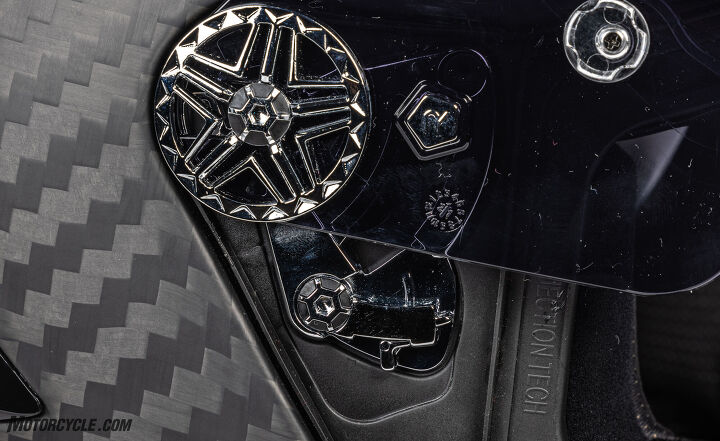
Can you see the tiny spring-loaded pin at the end of the horizontal arm at the bottom of the shield’s base plate? This is primarily what keeps the shield in place. It’s finicky to operate and could potentially break easily if one’s not careful.
Otherwise, the fit of the Thunder Carbon is very plush. It’s a comfortable place to be, and as soon as I put the medium helmet on my head, I felt comfortable right away, no changing of pads needed. Out on track, it’s worth mentioning again how large the viewing area is. You really don’t have any obstructions side to side or up and down. It’s impressive.
However, similar to my experience with Arais, the cheek pads of the LS2 contoured to my face after only a session or two, resulting in a fit that felt perfect when new, but was ultimately just a tiny bit loose. Thicker pads would potentially be the answer, but none were available at the time.

The LS2 is very comfortable, practically disappearing once at speed. And the huge eye port means nothing will block your field of vision. Photo: Dito Milan/Gotbluemilk.com
Ventilation seemed about average, though I had most of the vents closed for our track session because of the chilly temps. I’m happy to note I didn’t feel any air coming up from underneath the chinbar, which can be very distracting.
Overall, the LS2 Thunder Carbon is a nice, light, and comfortable helmet. Aerodynamics seem well thought out and the huge eye port can’t be understated. Maybe the shield changing mechanism will make more sense to me the more I use it, but it’s probably my biggest concern (and it’s not much of one).
Shop for the LS2 Thunder Carbon here
Scorpion EXO R1 Air
Price: $399.95 – $549.95 Tested size: M Weight: 3lbs 1.7 oz (1409.0 g) Safety Rating: DOT, ECEFor as long as I can remember, it seems like Scorpion has always been associated with cheapskates who couldn’t afford anything better. Hell, before I ever made a paycheck riding motorcycles, I was one of those cheapskates who longed for an Arai but bought a Scorpion instead. Whether deserved or not, Scorpion has had a reputation for being low- to mid-tier because of its inexpensive price point.
With the EXO R1 Air, Scorpion is out to prove a premium helmet doesn’t have to carry a premium price tag. Its $400 entry price (solid colors) is the lowest of the entire group here, and even at the high end, $550 is still less than the starting prices for many of the other helmets here. And what is a great way to change the minds of naysayers of your lids? Putting them on the heads of top-tier riders. Scorpion has done just that, as the EXO R1 can be found on the heads of World Superbike rider Alvaro Bautista and 2021 MotoGP champion Fabio Quartaro, among others. It doesn’t get any more top-tier than that.
Specifically, what we have here is the EXO R1 Air Carbon, which as you can see incorporates carbon fiber to its shell construction along with a mixture of other resins. The shell shape itself has been tuned to slice through the air cleanly and with little buffeting from the rear. Inside the helmet, you’ll find a multi-layer EPS liner incorporating ventilation channels to disperse the incoming air throughout the head.
When it comes to bang for the buck, Scorpion again makes a name for itself, because unlike some other brands, including other premium brands, Scorpion includes a dark tinted visor with each helmet. Both the clear and dark shields are ready for a Pinlock visor, which is convenient because one is included in the box. The shield change mechanism itself is super simple and easy to swap out without tools – just pull tabs to remove and then click the new one into place. The locking mechanism for the shield is now in the center and provides an audible click once locked into place. You can also feel it click even with gloved hands. However, the mechanism’s central placement is also right above the chin vent, which can lead to accidentally reaching for the vent when you’re really trying to open your shield. It’s a small nit to pick, but still…
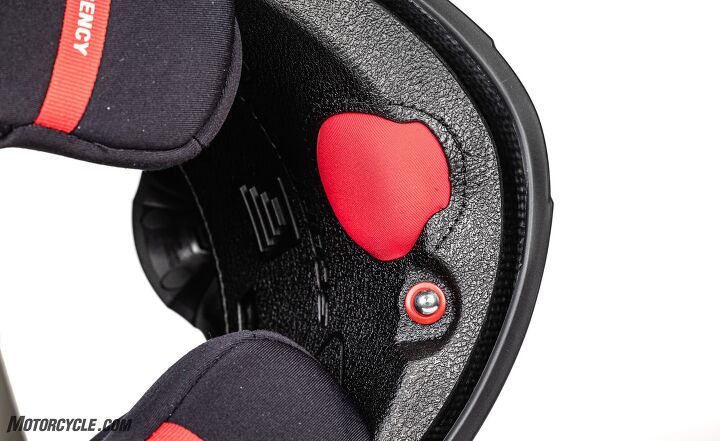
The huge red button is the pump to inflate the cheek pads, while the smaller button underneath releases the air when you’re done.
The coolest thing the EXO R1 Air has going for it is the AirFit inflatable cheek pads. Specifically, the R1 incorporates an inflatable air bladder between the shell and cheek pads with the pump (and air release) located at the bottom of the chin bar. Scorpion has been using inflatable cheek pads for a long time in several of its helmets, and while some may think it’s a gimmick, I’m a big fan.
Throughout this test I’ve mentioned how some helmets have required me to swap cheek pads in order to get the fit and feel exactly the way I like it (I’m pretty particular with the way my race helmets fit). With the EXO R1 this isn’t an issue. I can put the standard medium on my head, and even though the deflated fit isn’t so bad, pumping some air into them gets the fit just how I like it. You can’t take for granted just how convenient this is.
Otherwise, the EXO R1 fits right in with the other helmets in this test. Besides being comfortable, the interior liner is nice and plush, the view out of the eye port leaves nothing to be desired, it flows air with no noticeable buffeting, and it’s actually very quiet inside. Some would expect some faults from this $400 helmet, but in my experience anyway, the Scorpion EXO R1 Air Carbon has performed just as well, if not better, than many of the other helmets here. It’s very impressive.
Shop for the Scorpion EXO R1 Air here
Shark Race R Pro GP
Price: $999 – $1099.99 Tested size: M Weight: 3 lbs 9.4 oz (1627.3 g) Safety Rating: DOT, ECEIn stark contrast to the Scorpion, we have the Shark Race R Pro GP, which starts at $999. For that price you expect a lot, and to me, the difference with the Shark compared to most others is the fit and finish and the attention to detail throughout.
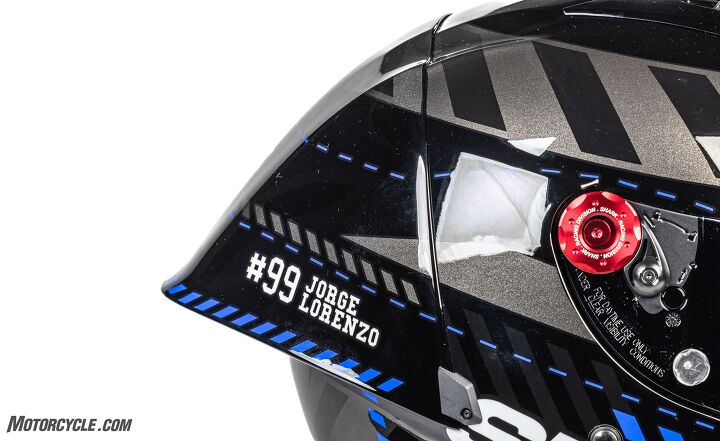
There’s no way around it, the Shark’s spoiler is huge. The result is the Race R Pro is dead stable at speed.
We’ll get to that in a minute, but we can’t start talking about the Race R Pro GP without going right to its most obvious feature: the huge whale-tail spoiler. Designed for the highest speeds reached by MotoGP machines, the spoiler is obviously designed to produce as little drag as possible, but Shark also says it “eliminates undesirable vibration effects” and offers the rider greater stability at high speed.
What’s my verdict? As much as we tend to laugh at marketing phrases that have lost some of their original meaning in translation, the aerodynamics of the Race R Pro, in my opinion, lives up to the hype. Its stability at high speed is incredible. My head is as stable as if I weren’t moving at all. It’s a very nice cocoon to be in, too, as there’s no wind coming from under the neck roll. As a byproduct, it’s also very quiet. Speaking of the neck roll, which is already very snug, the Race R Pro comes with an extension to the chin curtain to keep as much air out as possible. It snaps to the existing chin curtain, which in turn makes the Shark really tight to pull down over the head, but in my case anyway, once the helmet was on, it was amazingly comfortable. I’ve had a love/hate relationship with Shark in the past, partially because of some weird sizing issues, but this standard size medium fits perfectly.
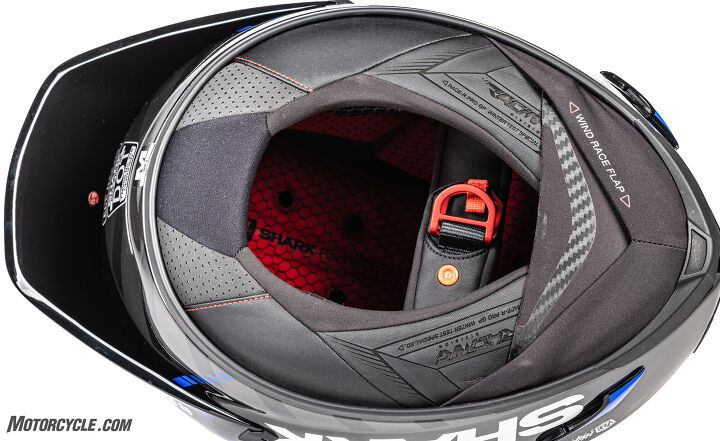
You can see the extension to the chin curtain to the right. This practically ensures no unwanted air is coming in from under the chin or the neck roll. The downside is the helmet is very tight to put on. But once it’s on your head, it’s luxurious inside.
This goes back to the bit about Shark’s attention to detail with this helmet. Its design and engineering team clearly did their homework when designing both the exterior and interior of the helmet, obviously paying close attention to the aerodynamics on the outside, but also to the little things like the chin curtain extension underneath. The shield change mechanism is really clever and basically requires you flip a tab to either the lock or unlock positions. From there you simply slide the shield in or out and flip the tab back. It’s incredibly secure and really easy. Speaking of the shield, it’s easily the thickest shield in this group. And the dark-tinted visor? They’re not kidding around. It’s dark. My eyes needed several seconds to adapt to just how dark it was, so if you’re planning on using it, make sure it’s a bright and sunny day outside.
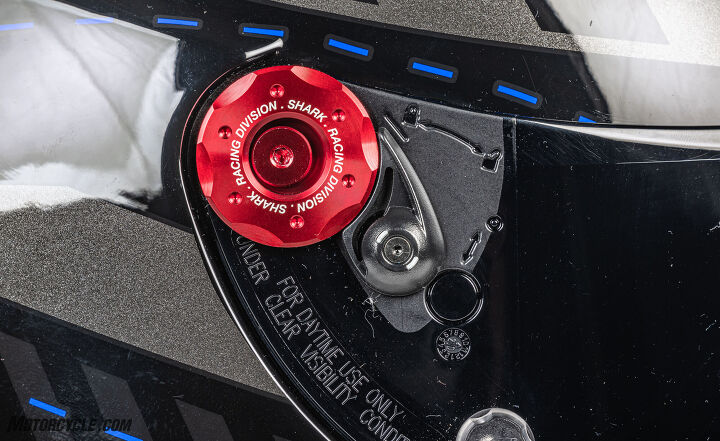
This simple switch locks or unlocks the shield for easy replacement. It’s really quite clever. Also, note the “For Daytime Use Only” warning. Shark’s not kidding about that one.
As for the helmet itself, the shell is made from a lightweight carbon/aramid fiber composite and is (oddly) available in only two shell sizes. However, unlike the other helmets in this test with limited shell sizes, Shark has found a way to make it work. At least for my head in the medium helmet. It’s DOT and ECE rated, and is overall a very impressive helmet. Of course, you expect it to be for that price.
Shop for the Shark Race R Pro GP here
Shoei X-Fourteen
Price: $769 – $879.99 Tested size: M Weight: 3lbs 9.4 oz (1627.3 g) Safety Rating: DOT, SnellThe Shoei X-Fourteen is a helmet needing no introduction. Like Arai, Shoei has been in the helmet game since forever. People know it. People love it. And if you don’t fit in an Arai, often a Shoei is the one for you. Years ago I remember an Arai representative who joked, “You know, if we didn’t exist, I’d put my head in a Shoei.” The two are seemingly linked together in the world of helmets, and interestingly enough, the Arai and Shoei are two-thirds of the group with a Snell safety rating (Bell being the third).
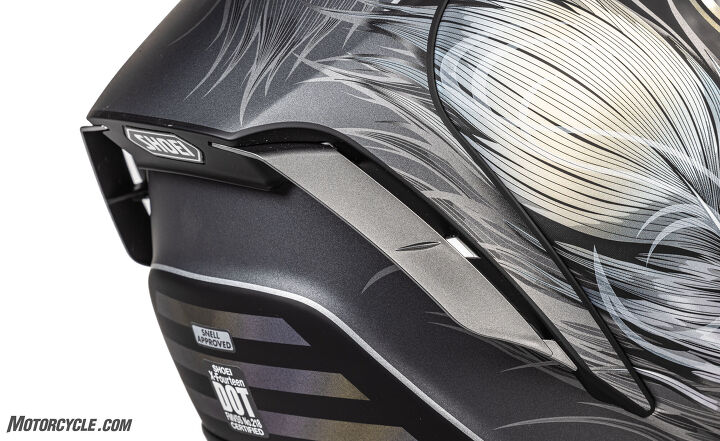
The X-Fourteen is tied for the heaviest helmet in this test, but you hardly notice it when wearing the helmet because of its efficient aero.
As far as the helmet itself, the shell is constructed from a proprietary matrix of different resins and fibers. Four different shell sizes and five EPS liner sizes are used to accommodate nearly any head within the X-Fourteen’s size range. The EPS liner also extends to the chinbar and incorporates Shoei’s cheek pad cooling system, too. From an aero perspective, the rear spoiler is adjustable by adding or subtracting flaps depending on the conditions and rider preference. A lower spoiler can even be added to the chin bar if more stability is needed.
Inside the X-Fourteen you’ll find a really plush interior. All of the pieces, from the cheek pads to the upper liner can be removed, washed, and replaced with different thicknesses if needed. Also, the cheek pads and center pad angles can be positioned up or down four degrees to give better vision from the eye port in the racer tuck position. A series of chin, brow, and top vents funnel in a lot of air.

Inside, the X-Fourteen is a nice place to be. the large chin curtain does an excellent job keeping unwanted air out.
The X-Fourteen is another personal favorite of mine, primarily because it fits so well right out of the box. I don’t need to replace pads or make any adjustments. It’s tied with the Shark as the heaviest helmet here, but once I’m wearing it and riding, it seemingly disappears. Credit for that goes to the efficient aerodynamics. Efficient aero and ventilation are tied together, and the X-Fourteen flows a noticeable amount of air to the rider’s head. What’s impressive is that, despite the amount of airflow, it’s not a loud helmet – which is more than can be said about the Arai.
Overall, the Shoei X-Fourteen is an impressive helmet that provides great comfort, efficient aerodynamics, and plenty of ventilation to keep your head cool. If you’re looking for a Snell-approved lid, give this one some consideration.
Shop for the Shoei X-Fourteen here
X-Lite X-803 Ultra Carbon
Price: $589.95 – $759.95 Tested size: M Weight: 3 lbs 6.2 oz (1536.6 g) Safety Rating: DOTThe X-Lite X-803 Ultra Carbon helmet may not be as well known on these shores as it is over in Europe, but plenty of really fast guys have put this (and its predecessors) on their heads to help develop it. You might have even heard of some of them: Danillo Petrucci, Chaz Davies, and Casey Stoner, just to name a few.
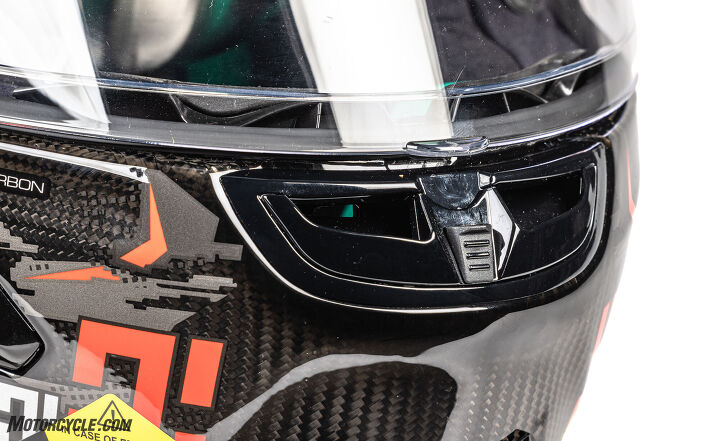
You can see the carbon fiber weave throughout the X-803, lending to its light weight. Also shown is the chin vent, which is shaped in such a way as to guide the finger to the tab in the middle of the visor to pop it open. Clever.
As you can guess from the name, the X-803 Ultra Carbon has a carbon fiber shell and three shell sizes to accommodate helmet sizes ranging from 2XS-2XL. What you don’t see from the X-803 is a crazy shape like, say, the Shark. This isn’t to say it isn’t an aerodynamic helmet, as I didn’t notice any unwanted vibrations or buffeting.
Another thing you don’t see (at least on units sold in America) is a Snell, ECE, or FIM sticker anywhere. Technically, the X-803 is only DOT certified. However, X-Lite sells this helmet in Europe, where it does have ECE certification. Further, considering there are MotoGP and WSBK riders who wear it, the X-803 (or a version of it, anyway) has also been FIM homologated. All that is to say there’s no reason to think this helmet won’t offer protection on par with anything else here.
Inside you’ll find a luxurious (and very green) liner. The eyeport is nice and big, and the shield change mechanism is another simple one to use, with a center button on both sides being all you have to push to release the shield. Ventilation-wise, you’ll find the standard chin vents, brow vents, and two top vents. The top vents especially don’t look all that substantial, but looks can sometimes be deceiving. Because our ride day was fairly chilly, I closed the vents on the X-Lite.
Here’s where things get a little weird. The X-803, while being a very comfortable helmet to wear, with great visibility, was also one of the louder helmets in this test. The weird part is it seemed air was sneaking in beneath the seal of the visor to the helmet, causing the noise. I checked multiple times to make sure the shield was properly in place, and even used the locking tab on the side to secure its position. The end result was the same. After doing some digging, I’ve seen others also notice the X-803 is loud – which isn’t unexpected for a racing helmet – but complaining of air flowing through the visor isn’t a result I’ve seen much of. Strange.

The X-Lite is very plus and comfortable inside, but the wind noise at speed was noticeably louder than most others here. Photo: Dito Milan/Gotbluemilk.com
The noise isn’t something you can’t get used to (especially with a good set of ear plugs), but perhaps a little more fine tuning of the faceshield is needed to ensure air doesn’t sneak in again (although I’m not sure what else to adjust). Despite that small finding, I was very impressed with the X-803. It’s very comfortable, fairly light (the small weighs in at 1460 grams), and gives a nice field of view. I didn’t even need to change cheek pads!
Shop for the X-Lite X-803 Ultra Carbon here
The Takeaway
So, what have I learned from this (not so) little experiment? I’ve learned that nearly all of the top-shelf helmets are very impressive feats of engineering and design. To find that balance between comfort, performance, and protection must be an incredibly challenging task, but all of these helmets seem to have done it. As mentioned before, there are no winners or losers in this test unlike our usual bike reviews. There are far too many variables at play to pick winners and losers, and besides – whichever one fits your head the best is going to give you great protection. From there, ventilation, aerodynamics, and price become your criteria. Rest assured there are no bad options.
We are committed to finding, researching, and recommending the best products. We earn commissions from purchases you make using the retail links in our product reviews. Learn more about how this works.
Become a Motorcycle.com insider. Get the latest motorcycle news first by subscribing to our newsletter here.
The post 2021 Motorcycle.com Mega Helmet Shootout appeared first on Motorcycle.com.
Copyright
© Motorcycle.com


